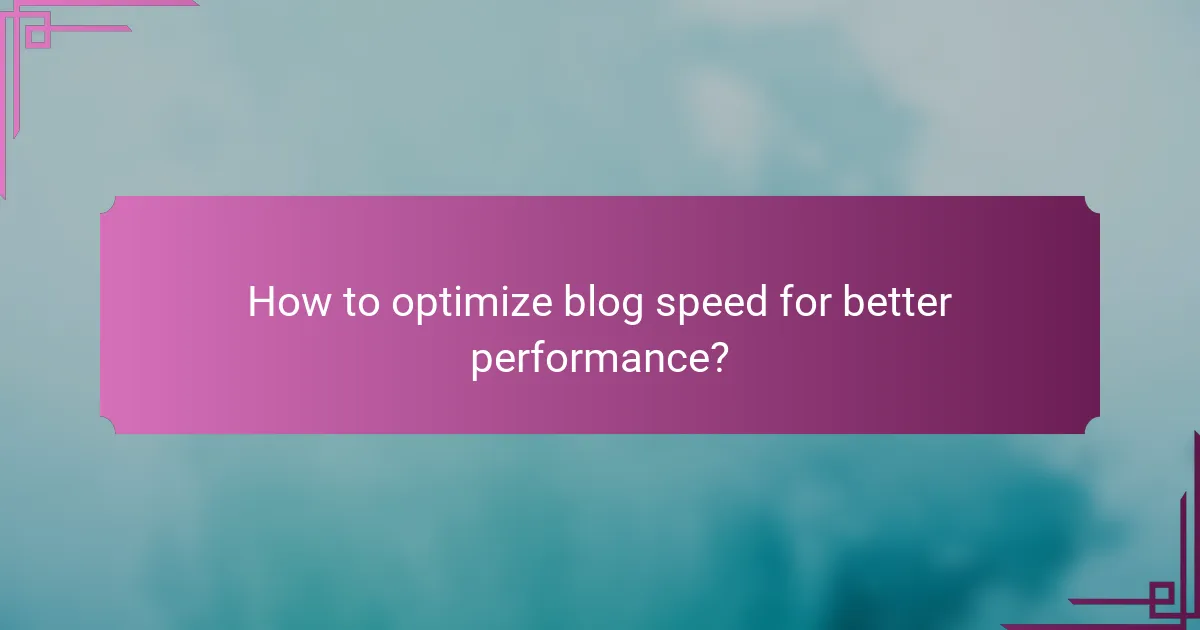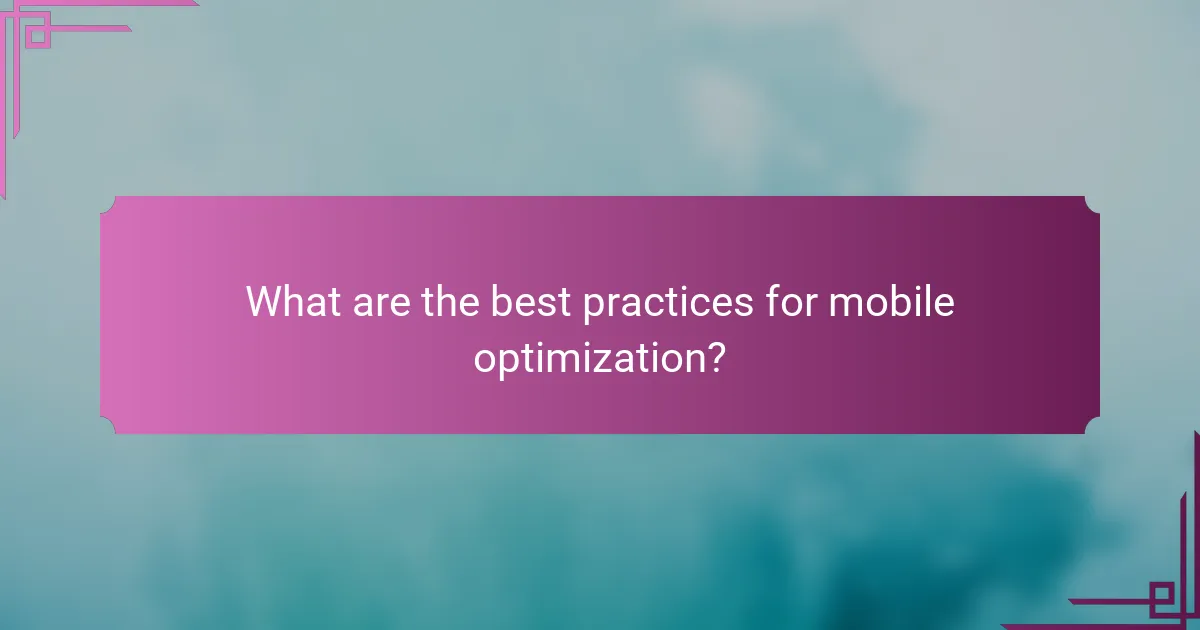Optimizing your blog for speed and performance is crucial for enhancing user experience and improving SEO. By focusing on reducing load times and tracking key performance metrics, you can create a more engaging environment for your visitors. A positive user experience not only keeps readers on your site longer but also boosts your search engine rankings, making it essential to implement effective optimization strategies.

How to optimize blog speed for better performance?
To optimize blog speed for better performance, focus on reducing load times and enhancing user experience. Faster blogs lead to lower bounce rates and improved SEO rankings, making it essential to implement effective strategies.
Use a Content Delivery Network (CDN)
A Content Delivery Network (CDN) distributes your blog’s content across multiple servers worldwide, reducing the distance data must travel to reach users. This can significantly decrease load times, especially for visitors far from your main server.
When selecting a CDN, consider factors like pricing, ease of integration, and performance metrics. Popular options include Cloudflare and Amazon CloudFront, which offer various plans to suit different needs.
Optimize images with tools like TinyPNG
Image optimization is crucial for improving blog speed. Tools like TinyPNG compress images without sacrificing quality, resulting in smaller file sizes that load faster. Aim for images under 100 KB whenever possible.
Additionally, use appropriate formats such as JPEG for photographs and PNG for graphics with transparency. Regularly audit your images to ensure they are optimized for web use.
Minimize HTTP requests
Reducing the number of HTTP requests can significantly enhance your blog’s loading speed. Each element on a page, such as scripts, stylesheets, and images, requires a separate request, which can add up quickly.
To minimize requests, combine CSS and JavaScript files, use CSS sprites for images, and eliminate unnecessary plugins. Aim for a total of fewer than 50 requests per page for optimal performance.
Leverage browser caching
Browser caching allows frequently accessed resources to be stored locally on a user’s device, reducing load times for repeat visits. By setting appropriate cache headers, you can instruct browsers to store certain files for a specified duration.
Consider caching static assets like images, CSS, and JavaScript files for weeks or months. Use tools like Google PageSpeed Insights to analyze your caching strategy and identify areas for improvement.
Implement lazy loading
Lazy loading defers the loading of images and videos until they are needed, which can significantly improve initial page load times. This technique is particularly effective for blogs with many media files.
To implement lazy loading, use JavaScript libraries or native HTML attributes like loading=”lazy” for images. This ensures that only the content visible in the viewport is loaded initially, enhancing user experience and performance.

What performance metrics should you track?
Tracking performance metrics is essential for optimizing your blog’s speed and user experience. Key metrics include page load time, Time to First Byte (TTFB), First Contentful Paint (FCP), and Largest Contentful Paint (LCP), each providing insights into different aspects of your site’s performance.
Page load time
Page load time measures how long it takes for a webpage to fully load in a user’s browser. Ideally, this should be under three seconds to minimize bounce rates and enhance user satisfaction. Tools like Google PageSpeed Insights can help you analyze and improve this metric.
To optimize page load time, consider compressing images, leveraging browser caching, and minimizing HTTP requests. Regularly testing your site’s speed can help identify bottlenecks that may slow down loading times.
Time to First Byte (TTFB)
Time to First Byte (TTFB) indicates the time taken for the browser to receive the first byte of data from the server after a request is made. A good TTFB is typically under 200 milliseconds. High TTFB can signal server issues or inefficient backend processes.
To improve TTFB, ensure your hosting provider offers reliable performance, optimize your server configuration, and use a Content Delivery Network (CDN) to reduce latency. Regular monitoring can help you maintain optimal server response times.
First Contentful Paint (FCP)
First Contentful Paint (FCP) measures the time it takes for the first piece of content to appear on the screen. This metric is crucial for user perception, as it indicates how quickly users can begin interacting with your site. Aim for an FCP of under 1 second.
Improving FCP can involve optimizing CSS and JavaScript files, using efficient loading strategies, and prioritizing visible content. Tools like Lighthouse can help you analyze FCP and suggest improvements.
Largest Contentful Paint (LCP)
Largest Contentful Paint (LCP) tracks the time it takes for the largest visible content element to load, such as an image or video. A good LCP score is under 2.5 seconds, as this significantly impacts user experience and engagement. Slow LCP can lead to higher abandonment rates.
To enhance LCP, focus on optimizing images, reducing server response times, and ensuring that your content is not blocked by render-blocking resources. Regularly testing LCP can help you maintain a fast and responsive site.

How does user experience impact SEO?
User experience (UX) significantly influences SEO by affecting how visitors interact with a website. A positive UX leads to better engagement, lower bounce rates, and higher conversion rates, all of which are critical factors for search engine rankings.
Improved engagement metrics
Engagement metrics, such as time on page and pages per session, are essential indicators of user satisfaction. When users find content valuable and easy to navigate, they are likely to spend more time on the site, which signals to search engines that the site is relevant and useful.
To enhance engagement, focus on creating high-quality, informative content and ensure that your website is easy to navigate. Use clear headings, bullet points, and images to break up text and maintain reader interest.
Lower bounce rates
A lower bounce rate indicates that visitors are finding what they need on your site and are not leaving immediately. High bounce rates can negatively affect SEO, as they suggest that users are not satisfied with their experience.
To reduce bounce rates, optimize your landing pages with compelling headlines, relevant content, and fast loading times. Consider implementing internal linking to guide users to additional relevant content, keeping them engaged longer.
Higher conversion rates
Higher conversion rates reflect successful user experiences that lead to desired actions, such as purchases or sign-ups. When users have a seamless experience, they are more likely to complete these actions, which can improve your site’s SEO performance.
To boost conversion rates, ensure that your website is mobile-friendly, loads quickly, and has clear calls to action. Regularly test different elements, such as button colors and placement, to find what resonates best with your audience.

What tools can help with blog optimization?
Several tools can significantly enhance blog optimization by improving speed, performance, user experience, and SEO. These tools provide insights and actionable recommendations that help bloggers identify issues and implement effective solutions.
Google PageSpeed Insights
Google PageSpeed Insights analyzes the content of a web page and generates suggestions to make that page faster. It provides a score from 0 to 100, indicating how well the page performs on both mobile and desktop devices.
Key factors include loading time, interactivity, and visual stability. Aim for a score above 90 for optimal performance. Common recommendations may involve optimizing images, leveraging browser caching, and minimizing JavaScript.
GTmetrix
GTmetrix offers a detailed analysis of your blog’s performance, including page load time, total page size, and the number of requests. It combines data from Google Lighthouse and Web Vitals, providing a comprehensive view of speed and user experience.
Utilize GTmetrix to identify bottlenecks in loading times and receive actionable recommendations. The tool also allows you to test your site from different regions, which is useful for understanding performance variations based on user location.
Ahrefs for SEO analysis
Ahrefs is a powerful tool for SEO analysis that helps improve your blog’s visibility in search engines. It provides insights into keyword rankings, backlinks, and competitor performance, allowing you to refine your content strategy.
Use Ahrefs to conduct a site audit, identify broken links, and analyze your content’s performance. Regularly monitor your site’s health and adjust your SEO tactics based on the data to enhance user experience and search engine ranking.

What are the best practices for mobile optimization?
Best practices for mobile optimization focus on enhancing user experience through responsive design, intuitive navigation, and fast loading times. Implementing these strategies ensures that your website performs well on mobile devices, meeting user expectations and improving search engine rankings.
Responsive design implementation
Responsive design allows your website to adapt seamlessly to various screen sizes and orientations. This approach typically involves using flexible grid layouts, images that scale, and CSS media queries to adjust styles based on device characteristics.
To implement responsive design effectively, prioritize a mobile-first approach. Start by designing for smaller screens and progressively enhance the experience for larger devices. Tools like Bootstrap or Foundation can simplify this process.
Mobile-friendly navigation
Mobile-friendly navigation is crucial for providing a smooth user experience. Simplify your menu structure by limiting the number of items and using clear labels. Consider employing a hamburger menu to save space while maintaining accessibility.
Ensure that touch targets, such as buttons and links, are large enough to be easily tapped without error. A minimum size of around 44×44 pixels is recommended. Test your navigation on various devices to confirm usability.
Fast loading times on mobile
Fast loading times are essential for retaining mobile users and improving SEO. Aim for a loading time of under three seconds, as delays can lead to high bounce rates. Optimize images, leverage browser caching, and minimize HTTP requests to enhance speed.
Utilize tools like Google PageSpeed Insights to identify specific areas for improvement. Consider using a Content Delivery Network (CDN) to reduce latency for users across different geographical locations. Regularly monitor performance to ensure ongoing optimization.

How to improve blog accessibility?
Improving blog accessibility means making your content usable for everyone, including people with disabilities. This involves following best practices and guidelines to ensure that all users can navigate, understand, and interact with your blog effectively.
Use descriptive alt text for images
Descriptive alt text provides context for images, helping visually impaired users understand their content through screen readers. Aim for concise, informative descriptions that convey the image’s purpose, ideally in 1-2 sentences.
For example, instead of using “Image1” as alt text, use “A group of people enjoying a picnic in a park.” This approach enhances the user experience and supports SEO by including relevant keywords.
Ensure proper heading structure
A clear heading structure helps all users navigate your content easily. Use headings (H1, H2, H3) hierarchically to organize information logically, making it simpler for screen readers to interpret.
For instance, start with one H1 for the main title, followed by H2 for major sections, and H3 for subsections. This organization not only aids accessibility but also improves SEO by clarifying the content hierarchy.
Provide keyboard navigation
Keyboard navigation is crucial for users who cannot use a mouse. Ensure that all interactive elements, such as links and buttons, are accessible via keyboard shortcuts.
Test your blog by navigating through it using only the keyboard. Common pitfalls include missing focus indicators or inaccessible dropdown menus. Make sure all elements can be reached and activated without a mouse.
Use sufficient color contrast
Color contrast affects readability, especially for users with visual impairments. Ensure that text color contrasts well with the background to enhance visibility.
A good rule of thumb is to aim for a contrast ratio of at least 4.5:1 for normal text and 3:1 for large text. Tools like the WebAIM Contrast Checker can help assess your color choices.
Implement responsive design
Responsive design ensures your blog adapts to various screen sizes and devices, improving accessibility for all users. This approach allows content to be easily readable on smartphones, tablets, and desktops.
Utilize flexible layouts and scalable fonts to enhance user experience. Test your blog on multiple devices to confirm that it maintains usability and accessibility across platforms.

